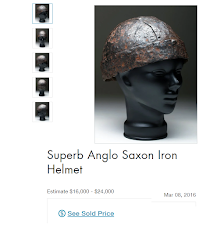evocative as helmets - many items of
war-gear can help paint a picture of ancient
battlefields, but in framing (or in some cases directly
representing) the face, helmets help to humanise warriors
from centuries past. This is particularly ironic given that, at least
in some cases, helmets in antiquity were designed to create an
Anglo-Saxon helmets are two a penny now it seems, Benty Grange, Sutton Hoo, Staffordshire (though see my earlier comments on this and here too, Coppergate, Wollaston Helmet, Shorwell helmet, possibly (but IMO doubtfully) the shoddy Yarm Helmet. In addition to these, Thegns of Mercia refer to "others without provenance or characteristically “Anglo-Saxon” features which litter private collections, auction sites, and episodes of Pawn Stars (https://youtu.be/nSdQGgRKiWI)" that cannot be included in the count.
Let's just take a look at that Pawn Stars video. It's an eye-opener. The first thing I notice is when Tattoo-man puts it on his head... it does not FIT on his head. It is circular, heads are not (it's the skull inside that's the problem). So that is a bit of a giveaway. Note also that when you do get a glimpse inside, there are no signs of any liner, of the attachment of anything holding it ON (chinstrap etc), cheek pieces or something guarding the nape of the neck. That's not how early medieval helmets worked. Secondly they are handling it with bare hands putting chlorides from their skin all over it.
Pawn stars helmet porn (Pawn Stars Season 17:
BIG MONEY for RARE "ONE-IN-A-MILLION" HELMET 19 Nov 2019
But then, oh, look it's Bob Darge from a well-known US antiquities dealership, and he's brought some equipment to analyse it. Comes in, measures the iron content, pronounces it real ("it's a one-in-a-million object") and walks off. Well, obviously the instrument shows its not resin, but in no way does the XRF "date" or authenticate the object. This is just idiotic posing with some technical-looking thing for the TV that may impress most viewers who've never ever done any XRF for themself and used the results (actually, I have). So we see the rather superficial way Mr Darge goes about authenticating an object. Note not a single question was raised about provenance and collecting history. The seller says "estate sale" without saying where and when even. If this were an Anglo-Saxon helmet, it would need a British export licence to legally leave the UK. Where is there any concern about that shown in this episode?
As I said, far from being "one in a million" helmets just like these are two a penny. And a proportion of them are already in the USA and... interestingly.... many of them are in some way associated with Bob Dodge of Artemis antiquities.
I discussed one of them earlier here (Rare 'Anglo-Saxon Helmet' on Sale in US) but.... actually, this is the same one that is being shown on the Pawn Stars programme, it was sold in June 2016 by Bob Dodge and now a guy ("Kevin") is shown claiming he got it with his sister in an estate sale "somewhere". Three years earlier the estimate was $25,000 - $35,000, now Dodge says it's worth "$15000". What has changed? So there's one more thing that is dodgy about this whole affair. "Provenance: Ex-private United Kingdom collection, acquired in the early 1980's. All items legal to buy/sell under U.S. Statute covering cultural patrimony Code 2600, CHAPTER 14, and are guaranteed to be as described or your money back. A Certificate of Authenticity will accompany all winning bids". What about the export licence?
In that post, I noted that this is the second one (at least) that Mr Dodge has sold recently to some collector or other.... with the same spiel and the same method of being put together. That one, "Superb Anglo Saxon Iron Helmet" Estimate $16,000 - $24,000, sold Mar 08, 2016 under the estimate for € 2.300. The surface is covered with some cruddy molasses-like black gunge, probably masquerading as some earlier conservation technique. "Provenance: Ex-private United Kingdom collection, acquired in the early 1980's. All items legal to buy/sell under U.S. Statute covering cultural patrimony Code 2600, CHAPTER 14, and are guaranteed to be as described or your money back. A Certificate of Authenticity will accompany all winning bids". What about the export licence? I am really puzzled by the shallow 'skull cap' form, not exactly very protective.
Provenance: Ex-private United Kingdom collection, acquired in the early 1980's.
Comes from my private collection (Michael P.)"










No comments:
Post a Comment